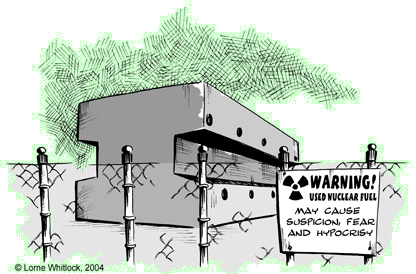Published in the May 2004
issue of the Canadian
Nuclear Society Bulletin, Vol.25, No.2. Artwork
by Lorne Whitlock.
All's Well That Ends Well by Jeremy Whitlock You mean “dispose”? No, “disposition”. We don’t dispose any more. But disposition isn’t a verb. Yes it is. Everyone uses it. You mean the ones who use “nuclear” as a noun, and “chair” instead of “chairman”? Yes them. Okay, so what “disposition” are we talking about? Safe. Secure. Monitored. Retrievable. Retrievable? It’s not really “nuclear waste” then is it? It’s “slightly-used nuclear fuel”. Not that kind of retrievable. Don’t even start talking about reprocessing. Just…retrievable. In case something goes wrong. Go wrong? What can go wrong? And in any case isn’t it less of a risk to dispose of it? Now stop talking about risk. That’s got nothing to do with public policy. Sorry. So, it’s retrievable because we might want to retrieve it, but not because it might be useful, and especially if we don’t dispose of it. Something like that. But isn’t this what we already do? Of course it is. But we did it without consulting the public. If it doesn’t have broad public support, it’s not safe. So now we’re consulting the public. But the experts say it’s safe right? Yes, but technical safety is only half of it: if it’s not “socially safe”, it’s only 50% safe. That’s what Energy Probe says. Oh I see. Then it must be right. Look, it’s attitudes like yours that got us where we are today: thinking that experts know what they’re talking about. That’s not fair. I don’t tell my doctor what to do. But people trust doctors. But doctors have killed more people than nuclear power ever will. Now you’re getting silly again. So how do we demonstrate “broad public support”? A referendum? Too impractical. We have to talk to small groups. Engage people. Show them the options. Ask their opinions. But didn’t we already do that? The Seaborn Panel did that for nine years. Yes.
Yes. And so aren’t we going to end up exactly where we started 40 years ago - storing high-level waste in safe, secure, monitored, retrievable configurations, without the express support of most of the population, and with an entire anti-nuclear cottage industry supported by the perception that a “final solution” is neither available nor possible? Yes. And what’s wrong with telling the public that this waste is actually pretty good, as waste goes: solid, robust, self-contained, getting less toxic all the time, relatively small in volume, and not really hard at all to deal with? Why spend millions going around in circles, ignoring the fundamental truth, perpetuating the careers of snake-oil salesmen who have never demonstrated a willingness or ability to represent the best interests of the grass-roots population they bleed money out of? You haven’t learned a thing I’ve told you. I’m leaving. And, for that matter, why hide the fact that “used fuel” is actually an energy resource for future generations? For heaven’s sake, we’re abdicating human ingenuity. La la la la la la. I can’t hear you.
| ||||
|
Discussion welcome.
©2011 Jeremy Whitlock
| ||||
|
|

 And didn’t they demonstrate broad public acceptance by receiving interventions from only a miniscule fraction of the population, largely special-interest groups and quite a number of them professionals at that? Isn’t broad public apathy a form of broad public acceptance, like that shown routinely for all forms of government policy in an open democracy?
And didn’t they demonstrate broad public acceptance by receiving interventions from only a miniscule fraction of the population, largely special-interest groups and quite a number of them professionals at that? Isn’t broad public apathy a form of broad public acceptance, like that shown routinely for all forms of government policy in an open democracy?